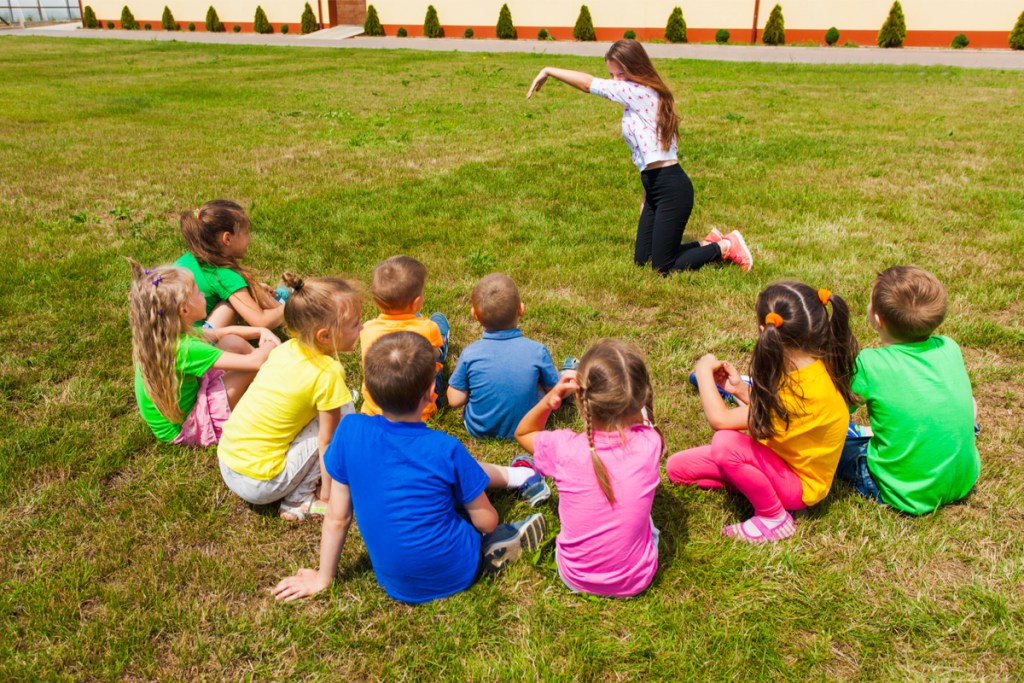Adults may know improvisational or improv games as icebreakers prior to workshops or meetings. Improv games are used a great deal in the theater, but it turns out improvisational exercises are actually pretty fun and a great teaching tool at home or in school for kids. Early-childhood educators already use a lot of improv games for kids during circle times, but playing improvisational games is something parents can do at home, too, especially in the car, at parties, or on inclement-weather days when the kiddos are bored.
Improv games are a wonderful teaching tool because they help younger children hone their communication, language, and listening skills along with cooperation and problem-solving skills. There are a lot of fun, easy improv games you can play with your 7-year-old and the whole family. Here are some to get you started.

One word at a time
This improv game is a classic preschool and early-elementary game. It can be played with an entire class of kids or just two, making it a perfect family game or something you can play one-on-one with your 7-year-old. Basically, the players create a story together, with each participant adding one word. It’s best to have the adult begin, but it’s not a hard and fast rule. You can play until an entire story takes shape or just do a quick round of five or 10 minutes and pick it up the next time you’re in the car.
Once upon a time
Just like one word at a time, this improv game sparks creativity with the participants telling a story together. The game begins with the first person tossing out the initial line of a story like, “It was a dark and stormy night.” Each player adds another line to the story until you have a conclusion. This is a fun game to play in the car on a long road trip.
Popcorn
If you’re having a party, popcorn is a sizzling game for a group of five to eight kids. It’s a quick game that’s often used in classrooms as a warm-up to an activity that requires sitting. Kids begin on the floor as a kernel of corn in a pan. An adult or older child serves as the narrator. The kernels are supposed to react to what the narrator is telling them. For example, the pan is heating up, or the pan is being shaken. The improv exercise culminates when the kernels pop into popcorn.
Same circle
This improv game sounds simple, but it’s actually more difficult than you think and requires concentration. It’s ideal for five or more players, but it can be played with two. The participants sit or stand in a circle. An adult or child can begin the game by making a small gesture. The next person must repeat the gesture, and it goes around the circle until the last person duplicates the gesture. Each gesture must be completely identical. You can continue the game by having someone else start off with a new gesture. The game can also be played with sounds.
Animal scenes
Seven-year-olds will really like this improv-acting exercise, which also makes for a cool game. It can be played with three or more players. One person serves as the leader, while the rest of the participants pair off. The leader gives the players different animal scenarios, like a monkey sitting in a tree. Each pair must act out the scenario. For example, one person would be the branch, and the other would be the monkey sitting on his or her partner.

Yes! Let’s _________!
Like popcorn, Yes! Let’s ___! is a great warm-up game or time-killer if you are waiting to go somewhere and the kids have a lot of energy. This game is perfect for groups, but it can be played with smaller numbers. It starts off with one person calling out an activity to do. For example, “Let’s jump.” Everyone answers, “Yes, let’s jump,” and begins to jump. After a few moments, another player calls out a different activity like “Let’s clap.” All the players respond with “Yes, let’s clap” and begin to clap. The game continues until each player has had the opportunity to call out an activity.
Just like adults, not all kids are going to be comfortable with improv games, and that’s okay. Even though kids may be a little hesitant at first, encourage them to participate. Improvisational games are considered icebreakers for a reason. They challenge people to come out of their comfort zones and interact in a way they normally wouldn’t. Improv games show kids it is all right and even a great idea to be silly sometimes or pretend to be someone or something else.
In addition to being fun, improv games are an outside-of-the-box educational tool, and they help children and teens develop their listening, language, communication, and problem-solving skills. If you’re hosting a party for your 7-year-old, these games are perfect for groups and keep kids busy during those long wait times.



